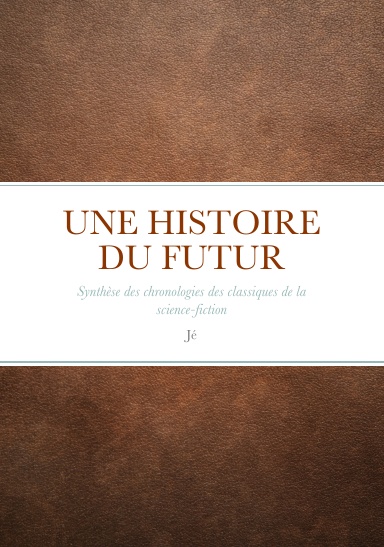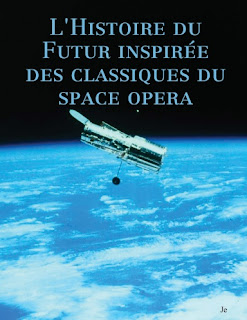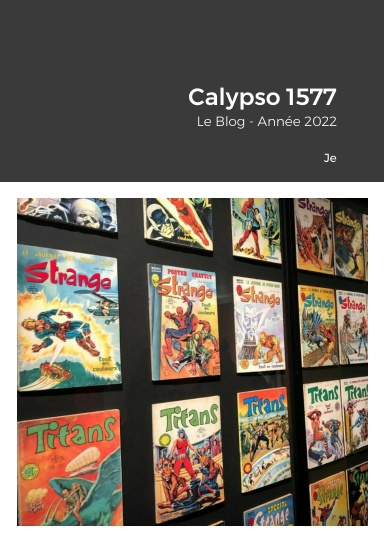2013/11/02 21:29 UTC
Cosmos with Cosmos is a weekly series that encourages people to
get together and watch Cosmos with a cosmo(politan) or drink of your
choice. We're posting weekly episode recaps and discussion through
February of 2014. This series is made possible by members of the
Planetary Society. If you like what you're reading, please consider joining the Society or donating $10 to help support projects like this in the future. To learn more about this series and find out how to watch Cosmos, see our introduction.
This special post is from Adolf Schaller, the creator of the painting shown below which was featured heavily in Cosmos, Episode 2, "One Voice in the Cosmic Fugue." He was kind enough to share the intense experience of creating this painting for the series back in the late 1970s.
-Casey Dreier
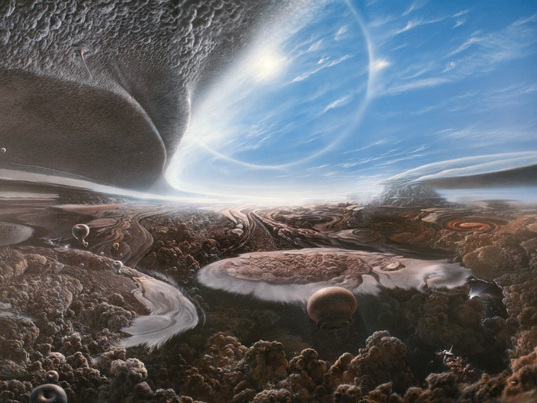
Adolf Schaller
Hunters, Floaters, and Sinkers
This painting speculates about possible forms of life on a Jupiter-like
gas giant. Airbrushed water-based acrylic. 90 x 120 in (7.5 x 10 ft).
Dimensions: 90 x 120 inches (7.5 x 10 feet)
Medium: Airbrushed water-based acrylic.
Construction: The HFS mural consisted of nine 30 x
40-inch illustration board panels mounted on a plywood backing. The 30 x
40-inch boards were individually worked as separate panels before
mounting using a high-quality rubber cement the day before the scheduled
shooting. This operation included the application of a special tape and
finishing touches to conceal the seams between the panels for the
sequence shooting and photography for the book.
Image scale: 1 degree of arc : 1 inch. Its angular
dimensions were thus a very wide-angle 90 x 120 degree view. The choice
vantage point for a viewer appreciating the entire scene was directly
over the center panel some 60 inches from the surface at that point.
However, no attempt was made to introduce the distortion which would
accrue from mapping a wide-angle area onto a flat surface. This was done
in order to permit the camera to zoom in and pan, 'truck' or travel
across any region of the painting without encountering any local
distortions.
In September of 1978 I received a phone call from Jon Lomberg and
Carl Sagan asking me if I would be interested in working on their
upcoming PBS science series, "Cosmos". Without hesitation I said yes.
They asked me about working on several subjects, but one in particular
held a special significance for Carl, and he was keen to see the concept
treated with as much realism and scientific accuracy as possible, as
well as investing it with an aesthetic that evoked a sense of wonder. He
wanted it to excite the imagination, to plausibly suggest what might be
within the realm of natural possibility. I shared his enthusiasm for
the topic; fortunately, I had good long head start on what would become
an unexpectedly daunting and difficult challenge.
It just so happened that I had been producing a series of
increasingly large paintings depicting the atmospheric environments of
Jovian-class or gas-giant planets - panoramic cloudscapes - for quite a
number of years previously, with the intention of eventually creating a
series based on hypothetical organisms and even whole ecosystems which
could conceivably evolve in such habitats. These early studies included
illustrations which appeared in Astronomy magazine and educational slide
sets produced by Encyclopedia Britannica (from 1974-1976), Starlog and
Future-Life magazines (in particular, a scene depicting a balloon probe
afloat above the cloudtops of Jupiter's Great Red Spot (1977), and a 30 x
40-inch Jupiter cloudscape depicting another balloon probe I had
donated to the Flandrau Planetarium in Tucson in 1977-1978.
My principle sources of inspiration came seven years earlier. On one
of my regular weekend visits to my favorite library back in 1971, I came
across a new arrival in the science section: a copy of the book, "
Intelligent Life in the Universe",

by Iosif Shklovskii as expanded by Carl Sagan, published in 1968. I was
15 at the time, and that book completely absorbed me. Their description
of a biosphere entirely suspended within and supported by an
atmospheric environment was my first exposure to the concept. By the
time I came across Arthur C. Clarke's 1972 short story, "A Meeting with
Medusa" not long after my reading of Carl's Cosmic Connection in late
1973, I was enchanted by the concept. A burgeoning ecosystem of diverse
creatures inhabiting the clouds of gas-giant planets became a
preoccupation, stimulating my imagination in many detailed conceptual
drawings and cloudscape studies.
I had by then already developed a serious interest in astronomy and
physics with the goal of obtaining a degree, but reading this book (not
long after studying Darwin's "On the Origin of Species", and Sagan's
"The Cosmic Connection" later on in 1973) had a powerful influence on my
thinking. It gathered my varied astrophysical interests and welded them
together within the context of life: the nucleosynthesis of heavy
elements, biogenic conditions in the interstellar medium, planetary
formation and environments conducive to prebiotic chemistry, the
establishment of microbial organisms and subsequent evolution and
potential elaboration of complex multicellular organisms, ecosystems,
societies, intelligence, technological civilizations, and so on. I
studied everything I could get my hands on dealing with the subject. I
began producing paintings and was immediately published. As it
transpired, with all of the commissions I soon acquired, I suddenly
found myself embarked on an early professional career as an astronomical
artist.
I had also begun to train myself in the use of airbrushes to more
easily and effectively accomplish the delicate details and appearance of
clouds with quick-drying water-based acrylic paints. Since the age of 8
I had been an avid sky-watcher, a student of meteorology as well as an
amateur astronomer. I had been fascinated by clouds for as long as I can
remember. (My very earliest memory is of a cumulus-filled sky brightly
back-illuminated by a high sun, over a wide tree-lined park; checking
with my mother, I believe the observation occurred from a baby buggy my
mom was pushing me along in as we strolled along a walk lining a lake
shore park on the North Side of Chicago in the Summer of 1957 when I was
perhaps 16 months old. It is an extremely vivid memory indelibly etched
in my mind...I have even toyed with reconstructing that scene. I might
attempt it one day, but it makes me nervous: it suggests an end to
memory).
In any case, I had amassed a large collection of cloud photographs
for my personal reference years before I had any intention of painting
clouds. In 1974 I discovered the venerable Paasche model AB extra
fine-line airbrush, an airbrush whose unique mechanical design had not
significantly changed since the 1930's and was used for photo-retouching
and by artists working on Walt Disney's early classic animated films
including 'Fantasia'. This unit became my principle tool in the creation
of most of my paintings, and it was the tool I introduced to all of the
members of the team of the Cosmos Artists (as we were known) in order
to facilitate a uniform consistency in the painted artwork for the
visual effects which we were to prepare.
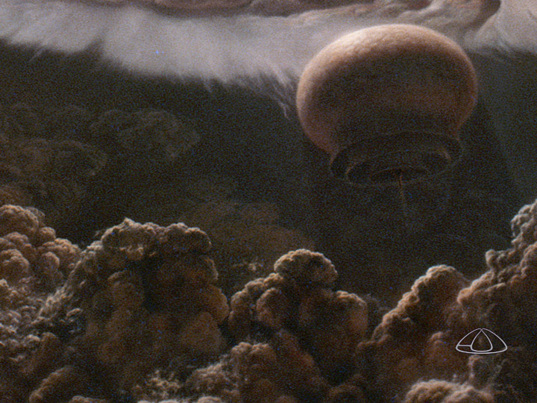
©Adolf Schaller
A "Floater" from Cosmos, Episode 2
Part of the larger mural, "Hunters, Floaters, and Sinkers" painted for the series.
Late that month of September, 1978, I was asked to immediately begin
preparing preliminary concept drawings for what would become HFS while I
was still at home in suburban Chicago. (At the same time I was also
asked to begin painting a sequence consisting of four 15 x 20-inch
panels depicting the final stages of our Sun's life, named by the title I
gave to the first painting in the sequence, "The Last Perfect Day",
which Carl subsequently altered slightly to, "The Last Good Day". That
first painting was the very first of thousands of separate pieces of
artwork I would contribute to the show over the better part of a year -
from conventional paintings and artwork painted on flat acetate sheets
for multiplane animation fx to tabletop models, planetary globes,
asteroids and other models).
By the time I arrived in Los Angeles on February 13, 1979 to join the
team of Cosmos Artists and work on the production of the visual
effects, I had completed many dozens of preliminary concept drawings of
the basic design of the HFS cloudscape environment, along with about a
hundred conceptual designs for a variety of species of the three
principle types which constituted the hypothetical biosphere and its
ecological system: Hunters, Floaters and Sinkers - creatures with
diverse shapes and anatomies, aerodynamic and buoyancy properties,
propulsion mechanisms, feeding modes, social and navigation or migratory
behaviors, communication, reproductive and defense and even stealth
strategies, and more, that would not only fit them for life within a
global atmospheric habitat, depending on conditions at various altitudes
and within clouds of various composition, as well as the other dynamic
aspects of weather, but also provide the basis for local or close-range
interaction with other individuals of the same or different species,
either in encountering those of their own kind (for reproductive
purposes, or to maintain mutual proximity in gregarious social
collections, for example), in encountering potential prey (Floaters
grazed on diminutive but abundant Sinkers, while Hunters ambushed
Sinkers for their stores of purified hydrogen as well as for nutrition),
or encountered potential predators (both Floaters and Hunters could
evolve elaborate defense strategies against attack by other Hunters).
Carl's early speculations on Jovian atmosphere life in the 1960s had
evolved and he eventually worked out the basic hunters, floaters and
sinkers ecosystem which he described in a paper with Ed Salpeter:
"Particles, Environments, and Possible Ecologies in the Jovian
Atmosphere", which appeared in The Astrophysical Journal, Supplement
Series in late 1975. Meanwhile I had been exploring the wide range of
potential planetary habitats and designing a great many life-forms in
the fleshed-out detail necessary for illustration, that could
conceivably evolve and flourish within habitable environments, including
Jovian-type atmospheres.
As I already mentioned, I had the benefit of a decent head start: I
had been studying the range of potential conditions of gas giant
atmospheres, considering those environments as potential habitats
supporting hypothetical biological communities for years before I was
called to work on Cosmos, and I had already composed a number of
cloudscapes that prefigured HFS. In fact, much of the basic cloudscape
is derived from the painting I donated to the Flandrau Planetarium in
the spring of 1978, a work I had started on nearly 2 years before I
commenced work on Cosmos that fall.
I began work on the main Cosmos VFX within several hours of my
arrival. I was whisked from LAX to KCET-TV, which is located at the
juncture of Hollywood and Sunset boulevards, stood around the offices
for a while waiting on another team member, then off we went to the fx
studio the show had contracted to perform the main fx, called Motion
Pictures Incorporated (MPI) located over the Hollywood hills in Burbank
to the north. The Cosmos Artists residence came to be called 'the
Artists Apartment', which was actually a rented 3-bedroom house located
in a relatively quiet residential neighborhood several blocks east and
within walking distance of the KCET offices. We outfitted the house as
an artist's studio, each of us working in their own bedrooms, or
collectively in the living room/dining room on bigger projects like the
large 4-foot diameter Earth globes - a surface globe prepared by Don
Davis on which several of us pitched in on to help, and a separate
'cloud globe' of the same size that was my responsibility. The trip
between the house to MPI in Burbank was our daily commute. That first
night, returning from Burbank, and after that exhausting day that began
early that morning in Chicago, I began work on HFS by preparing the
first of what I thought would total at least three, but not exceed five
30x40-inch panels.
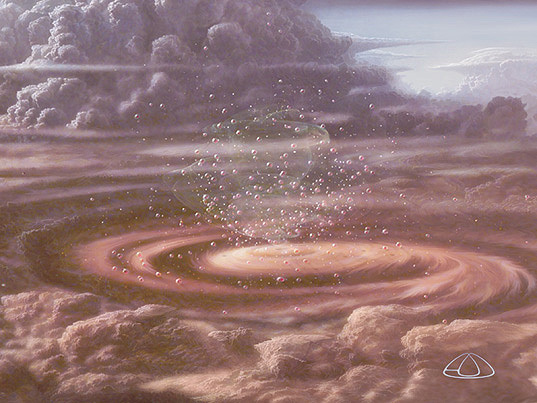
©Adolf Schaller
A Lazy Herd of Floaters
An updated digital restoration by Adolf Schaller of detail in his
original Hunters, Floaters, Sinkers mural which appeared on Cosmos,
Episode 2, which speculates about life in the atmosphere of a gas-giant
planet.
That was to change drastically within the next month. The middle
three panels covered the panorama centered along the horizon. I thought
at first this might be sufficient, but I found that there would be many
opportunities to explore the cloudscape far beneath and high above our
apparent position (which I had calibrated by cloud type and other cues
suggesting that the viewer was located at about the 1 bar level,
assuming ideal smooth and laminar pressure gradient unaffected by
weather). I had arranged for a wide-angle view with a scale of 1 Degree
of arc to the inch.
It was an extremely exciting time for us: one must keep in mind this
was just weeks away from the first of the Voyager flybys of Jupiter that
March, and we all marveled at the awesome images Voyager had been
returning of those incredible cream-in-coffee clouds with
ever-increasing resolution. I was especially keen on studying them to
gain some insights I could transfer into the painting. At the same time,
I was preparing an accurately oblate 18-inch-diameter Jupiter model for
several vfx sequences, and Voyager image prints made available to the
press by JPL were indispensable references. Not every image Voyager
returned was printed, however. I therefore petitioned to spend the night
of closest approach at JPL so that I could study the raw images as they
were displayed on the monitors.
As an aside, I should mention that we had visited JPL on several
previous occasions to see Jim Blinn, who had created astonishing
computer simulations of the Voyager flybys and who would be contributing
a number of those along with other sequences to the show. Jim's
groundbreaking work pioneered the digital fx revolution everyone enjoys
in the motion picture industry today.
The computers he had at his disposal at JPL were costly, huge and
slow by today's standards - it took many days for his setup to render
sequences of a few minutes length. But the results were gorgeous and
mesmerizing. I knew that I was seeing the future in his lab, but I never
dreamed then that it would arrive as soon as it has and with such an
astonishing boost of capacity and speed. Jim insisted he could never
match the complex effects we were performing through traditional
animation methods and camera moves on models and artwork, but it was
certainly obvious to me that none of us could replicate the accuracy of
the motions and trajectory of that little virtual Voyager I saw
pirouetting on his monitors. Jim's sequences had the look of
authenticity which was notoriously difficult to achieve via traditional
vfx methods.
In any case, it was on one of those visits that I noticed there were
half a dozen large monitors set up in an out of the way corner of the
lobby to the von Karman auditorium, where members of the press
congregated, and it occurred to me to be a perfect place to
unobtrusively watch during the spacecraft's flyby. But it turned out
that it was a surprisingly tough sell - nobody thought that an artist
required any such referential input. This puzzling and exasperating
attitude introduced me to a commonly held view amongst scientists and
producers alike that art somehow springs spontaneously out of uninformed
or unstimulated gray matter.
I was increasingly anxious as the flyby approached to have my request
granted, so I asked to meet with Carl privately over at the Artist's
Apartment. I had been enforcing a strict policy of keeping my work on
the HFS panels under quarantine: nobody could see them except Carl and a
few confidants on the team. The reason for this was to avoid
unnecessary disruptions and preserve my concentration against the
well-intentioned suggestions and advice of people. (I liken the
phenomenon to rearranging the furniture physically without being able to
visualize whether a given configuration is optimum: if it was up to
some, a given project would change course so often it would never get
done. The execution of a work is not a time to get distracted by
experiment - that's supposed to be settled with the preliminary
conceptual studies).
To my delight, I got my chance to plead my case: Carl accepted my
invitation to stop by about a week before the flyby, and I displayed the
three central panels arrayed along the horizon, propped up against the
wall side-by-side, to show him how it was progressing. By that time I
had finished most of the areas within 8 to 16 inches of the horizon
centerline and had roughed out the rest of the cloudscape throughout the
remaining area of the panels.
I was very gratified at Carl's reaction to it - he spent several long
silent minutes in front of the panels, slowly shifting from one side to
the other, his eyes scanning the detail along the horizon and the
structures I had established above and below it. When he began to speak
he grew really excited and I fielded his questions the best I could. I
showed him what I had begun to prepare in two additional panels that
could be positioned at the upper left and lower right corners to give
the camera a view of regions close up, far down below and high overhead,
where much of the details of the organisms that I had sketched could be
established. I ventured the possibility of adding two more panels
beneath and above the center panel as well, reiterated that the amount
of work involved in covering so much area on these boards with a uniform
level of detail was very time-consuming and laborious, and that the
schedule may not permit me to get that far to finish those. He stood in
front of the scene and stepped back a few paces as if to take in the
entire scene in his imagination, while pondering silently for another
full minute. Then he said, "Let's fill out the whole thing and make it a
full nine panels."
My initial elation at his reaction to the painting turned to stark
terror. I remember a very unpleasant queasy feeling in the pit of my
stomach as my mind automatically calculated the area involved and I
guess I was at a momentary loss for words. (10,800 square inches - 75
square feet of area to cover with millimeter resolution detail - it was
petrifying). I finally managed to croak out something about how I didn't
have enough time to devote to something that large and keep up my
responsibilities with the rest of the effects. He simply said "Don't
worry, we'll find a way", and just like that the matter was decided.
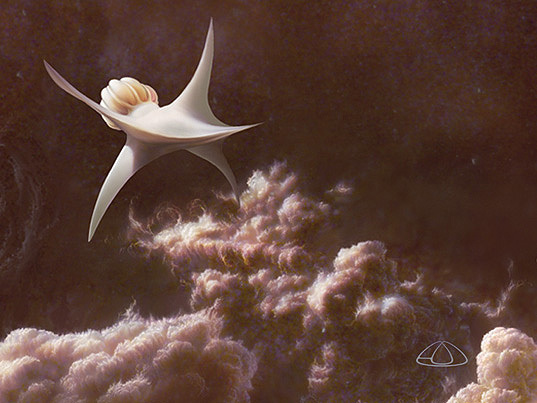
©Adolf Schaller
A Hunter
A speculative hunter animal evolved in the atmosphere of a gas-giant planet. Developed for Cosmos, Episode 2.
I must have been showing my shock, because he cheerfully changed the
subject onto my request to go to JPL for the Voyager flyby. He
reiterated the fact that he didn't want HFS to reflect an explicit
association with Jupiter. I said I understood that perfectly that it was
to be a portrayal of a hypothetical but generic gas giant world. But it
was nevertheless an important opportunity to gain an insight into gas
giant atmospheres. After all, Jupiter is a gas giant planet - and nobody
had ever seen what those clouds really look like at the sub-km
resolution that Voyager would soon return. I considered it vitally
important to the painting, and I said so. It really is that important if
an artist is expected to realize a visualization with maximum realism
and accuracy. (It is generally under-appreciated that the task of
portrayal compels artists to explicitly define the subject - we can't
always enjoy the luxury of ambiguity in dealing with our subjects). I
added that those monitors around the side of the auditorium lobby were
all I wanted to be able to sit in front of so I could sketch and take
notes. He smiled and nodded and said, "Good! I'll arrange it!" And with
that our meeting ended.
So I was there at JPL during the flyby. As full of people as the
auditorium was, that corner was deserted and eerily quiet all that
night. But I didn't pay much attention to that. My eyes and attention
were glued to the monitors and I was soaking in every image that came
up. It was a mesmerizing night; it was as if my mind was transported to
the spacecraft. The memory of it often returns to haunt me in quiet
moments to this day...and, yes, it contributed a great deal - in some
places crucially - to HFS. The main insight that was impressed on me
that night was the prevalence of vortices and eddies, as especially
evident in the turbulent region downstream of the GRS, and in the
interactions between ovals and along the boundaries between bands and
zones, right down to the limit of resolution. In suitably turbulent
regions, vortices and eddies were evident down to the limit of
resolution. That was the single most important insight I derived. It
suggests the preponderance of vortices below mesocyclone scale, and the
vigorous convection evident in many regions is more than sufficient
implication: Jupiter and many other gas giant worlds with deep
convective atmospheres must be full of tornadoes at every scale from the
monstrous down to whirlwinds.
One consequence of the insight on the mural appeared in the form of a
large cyclone reddened by a high population density of "Sinkers" (the
analogue of plankton in earth's oceans) concentrated there to exploit
nutrients updrafted from the depths below. Sinkers are comparatively
tiny, ranging from microbial to large party balloons in size (many of
the larger examples ranging upwards toward weather-balloon-size being
newborn and juvenile Floaters and Hunters), so we only see the reddish
coloration of the vortex from a distance of a few hundred kilometers,
but their presence is also indicated by what they have attracted: a
congregation of "Floaters" lazily grazing on them or giving birth to
them in great numbers over the spot, in a vaguely helical pattern
resembling the molecule of life. Strong convection and turbulence in
Jovian atmospheres is often cited as a detriment to the evolution of
organisms within them, yet such cyclones can conceivably play a
crucially important role in concentrating nutrients and provide stable
refuges.
I also added a more conventionally recognizable 'twister' emerging
out from the ceiling of the canopy at the upper left because I wanted to
give the camera a chance to come across one unobstructed funnel, and
there was no other convenient place to place it. Its bothered me because
strong vertical convection of the sort typically required to form them
would normally not be taking place within a laminar stratus plume of
that kind. It was placed there for the convenience of the shoot: it
wouldn't be very noticeable in the long shots, but only when the camera
panned over the region at close quarters, making the ceiling resemble
the base of a convective cell.
I spent an estimated average of 4 hours of our typical 14-hour day on
it every day over the following 7 or 8 months. Some days it was
difficult to find a half hour for it - on those days I was too exhausted
from pressing duties elsewhere in the fx production. To my dismay that
workload had increased apace with the added challenge of filling out
nine entire panels for HFS. The docket was exhausting.
I don't recall what month HFS was finally ready for the shoot. (I was
far too exhausted by then to notice and, frankly, the Southern
California climate doesn't provide one who grew up in the upper Midwest
and used to annual snowfall enough cues to impress what season it might
be...but I think it had neared the end of 1979 by the time I had
finished HFS for the shoot). I do remember that the final push was a
2-week period staying permanently awake, like a zombie. It's like
sleepwalking, except that though you know (or think you know) you are
awake and your eyes are open, you are in a constant dreaming state. It
was dreadful. I don't remember anything I painted during those closing
weeks except for flashes of the final touch-ups on the stage at KCET.
But I do remember it took me a very long time to recover.
The sequence was shot with director Adrian Malone having Carl
physically walking, speaking and gesturing in front of it. Adrian
meticulously choreographed the camera moves that panned over and zoomed
into sections of the mural to show some of the detail in it with Carl's
narrative voice-over. I was not present at the shoot: I was passed out
in bed in our new apartment in Santa Monica, not remembering how I got
there. I think I was out for almost 3 days. After HFS there were odds
and ends as the work load rapidly eased off. It was the last major
artwork or fx sequence of the production. It was rescheduled that way to
help give me all the time possible (I'm pretty sure, under Carl's
instructions) but it was The Monster among monsters.
Later the next year after Cosmos had aired, I and my fellow vfx
colleagues (belonging to both the Cosmos Artists team and the crew who
worked at Magicam noteworthy for their excellent Alexandrian Library and
the Cosmic Calendar sequences) were awarded the 1980 Prime-Time Emmy
Award for Outstanding Individual Achievement, Creative Technical Crafts.
We assembled up on the stage and accepted the award to a long ovation.
To my consternation my colleagues kept ushering me forward toward the
dais to make the first comments. I was reluctant - I'm not good at
speaking, let alone publicly. All I could manage was to thank my parents
and a special friend for their support. But the one person who inspired
me to explore the possibilities more than any other was Carl Sagan.
Source :
http://www.planetary.org/blogs/guest-blogs/2013/20131023-on-hunters-floaters-and-sinkers-from-cosmos.html
 Ce
genre est à la fois prisée pour ses aventures trépidantes, ses horizons
illimités et ses rencontres inattendues, mais aussi méprisée pour ses
intrigues à peine démarquées des romans noires ou des romans de guerre,
avec souvent le sort de l'univers entre les mains d'un super-héros.
Frank Herbert, l'auteur d'une des plus célèbre saga de space-opéra avec
"Dune" a su déjouer les pièges de la facilité en retenant pour scène
une seule planète sur fond certes d'imperium galactique mais en
inventant des combinaisons inédites à partir d'éléments puisés dans un
grand nombre de cultures. Le space-opéra domine la production littéraire
de SF au cours de l'âge d'or mais commence à régresser dans les années
50. C'est à cette période que le space-opéra va se modifier et passer de
la thématique de l'exploration purement géographique à celle du
développement de l'espèce humaine.
Ce
genre est à la fois prisée pour ses aventures trépidantes, ses horizons
illimités et ses rencontres inattendues, mais aussi méprisée pour ses
intrigues à peine démarquées des romans noires ou des romans de guerre,
avec souvent le sort de l'univers entre les mains d'un super-héros.
Frank Herbert, l'auteur d'une des plus célèbre saga de space-opéra avec
"Dune" a su déjouer les pièges de la facilité en retenant pour scène
une seule planète sur fond certes d'imperium galactique mais en
inventant des combinaisons inédites à partir d'éléments puisés dans un
grand nombre de cultures. Le space-opéra domine la production littéraire
de SF au cours de l'âge d'or mais commence à régresser dans les années
50. C'est à cette période que le space-opéra va se modifier et passer de
la thématique de l'exploration purement géographique à celle du
développement de l'espèce humaine. Ce
genre est à la fois prisée pour ses aventures trépidantes, ses horizons
illimités et ses rencontres inattendues, mais aussi méprisée pour ses
intrigues à peine démarquées des romans noires ou des romans de guerre,
avec souvent le sort de l'univers entre les mains d'un super-héros.
Frank Herbert, l'auteur d'une des plus célèbre saga de space-opéra avec
"Dune" a su déjouer les pièges de la facilité en retenant pour scène
une seule planète sur fond certes d'imperium galactique mais en
inventant des combinaisons inédites à partir d'éléments puisés dans un
grand nombre de cultures. Le space-opéra domine la production littéraire
de SF au cours de l'âge d'or mais commence à régresser dans les années
50. C'est à cette période que le space-opéra va se modifier et passer de
la thématique de l'exploration purement géographique à celle du
développement de l'espèce humaine.
Ce
genre est à la fois prisée pour ses aventures trépidantes, ses horizons
illimités et ses rencontres inattendues, mais aussi méprisée pour ses
intrigues à peine démarquées des romans noires ou des romans de guerre,
avec souvent le sort de l'univers entre les mains d'un super-héros.
Frank Herbert, l'auteur d'une des plus célèbre saga de space-opéra avec
"Dune" a su déjouer les pièges de la facilité en retenant pour scène
une seule planète sur fond certes d'imperium galactique mais en
inventant des combinaisons inédites à partir d'éléments puisés dans un
grand nombre de cultures. Le space-opéra domine la production littéraire
de SF au cours de l'âge d'or mais commence à régresser dans les années
50. C'est à cette période que le space-opéra va se modifier et passer de
la thématique de l'exploration purement géographique à celle du
développement de l'espèce humaine.
